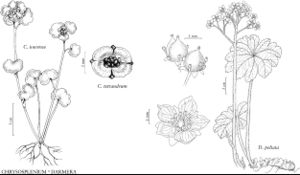Darmera
Gärtn. Zentralbl. 1: 645. 1899 ,.
Herbs, not rhizomatous, not stoloniferous; caudex 1–5 cm diam., scaly. Flowering stems (appearing before leaves), erect, leafless, 30–100(–150) cm, sparsely to densely stipitate-glandular to hispid. Leaves in basal rosette; stipules present; petiole present, attachment to blade peltate, sparsely stipitate-glandular to glandular-hispid; blade orbiculate, peltate, cupped in center, 6–15-lobed, sinuses ± deep, ultimate margins irregularly serrate, apices of lobes acute, surfaces glabrous or scantily stipitate-glandular and hispid on veins abaxially, glabrous or scantily short stipitate-glandular adaxially; venation palmate. Inflorescences ± flat-topped, compound cymes, arising from terminal bud in rosette, 60–75-flowered, usually ebracteate. Flowers: hypanthium completely adnate to ovary, green to pinkish purple; sepals 5, greenish to pinkish purple; petals 5, white to pink; nectary tissue not seen or inconspicuous; stamens 10; filaments subulate; ovary superior, 2-locular, carpels connate proximally; placentation axile, appearing marginal; styles 2; stigmas 2. Capsules folliclelike, 2-beaked. Seeds dark brown, prismatic or angular, cellular-rugulose. x = 17.
Distribution
w United States.
Discussion
Peltiphyllum Engler in H. G. A. Engler and K. Prantl, Nat. Pflanzenfam. 53[III,2a]: 61. 1891, not Peltophyllum Gardner 1843
Species 1: w United States.
Species 1
Selected References
None.
